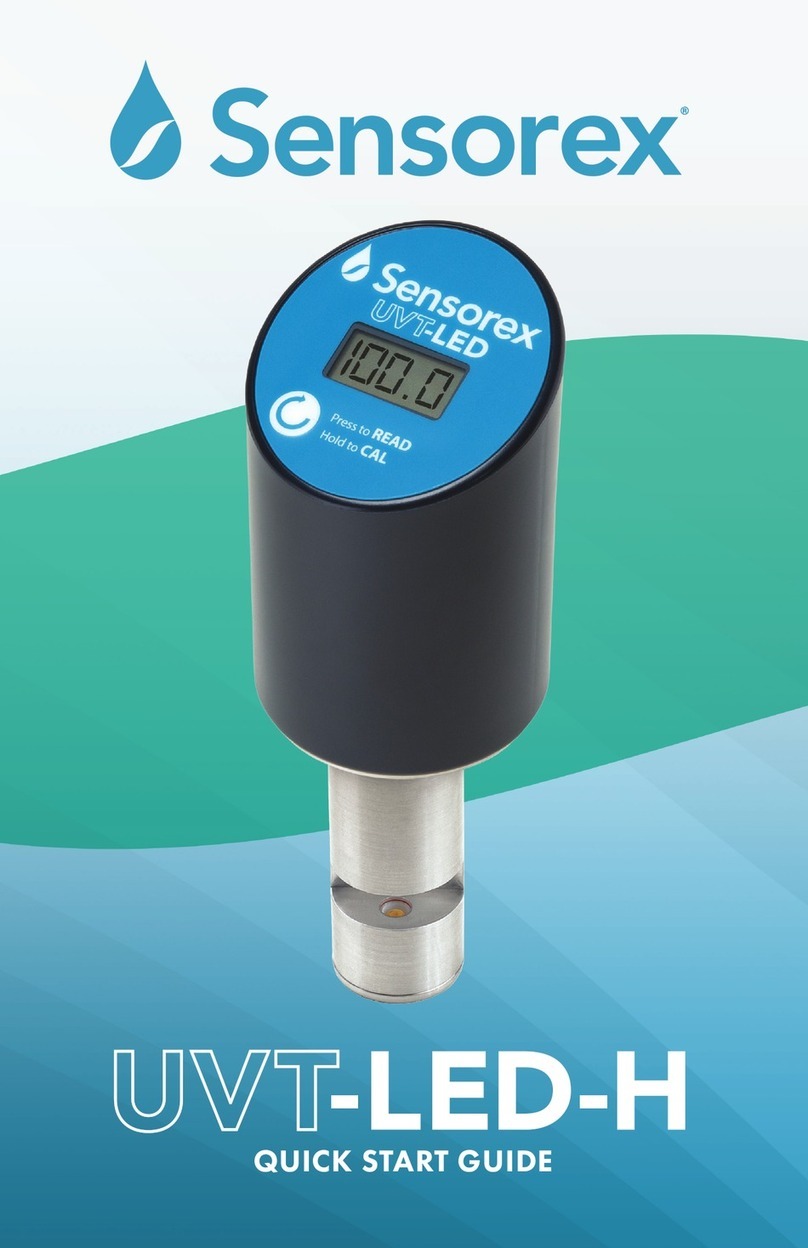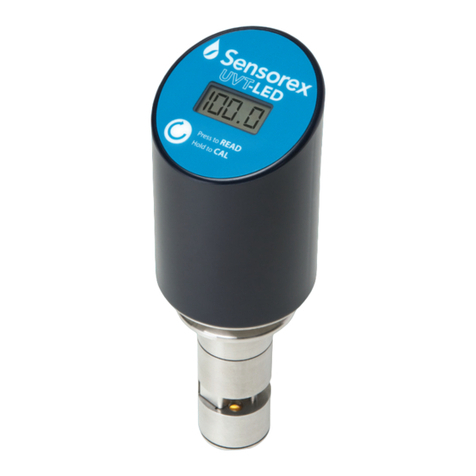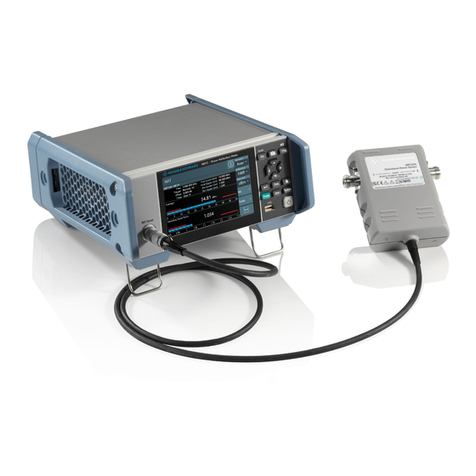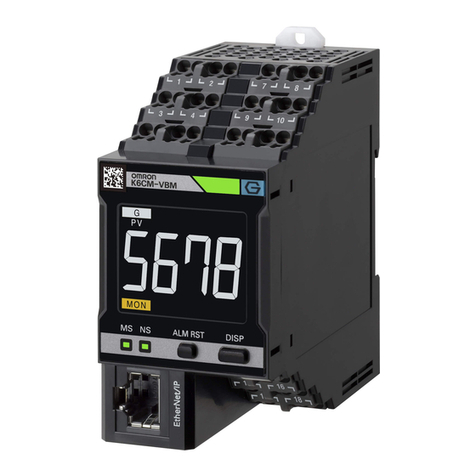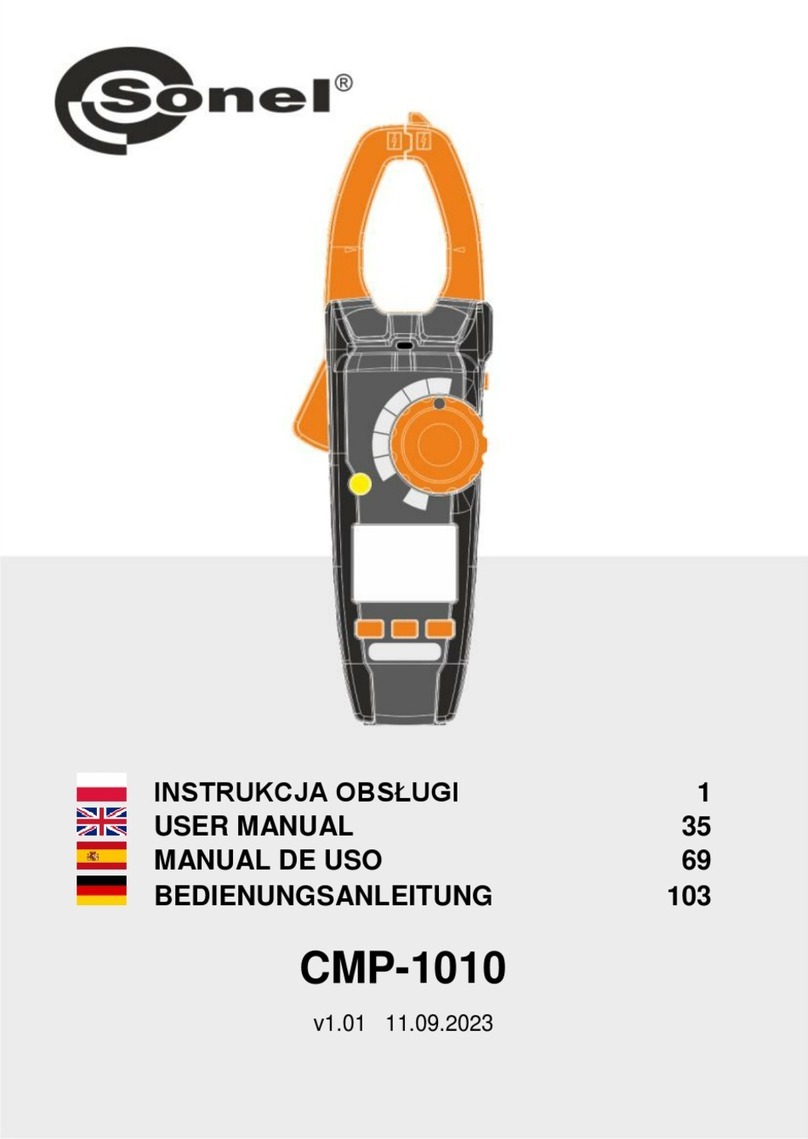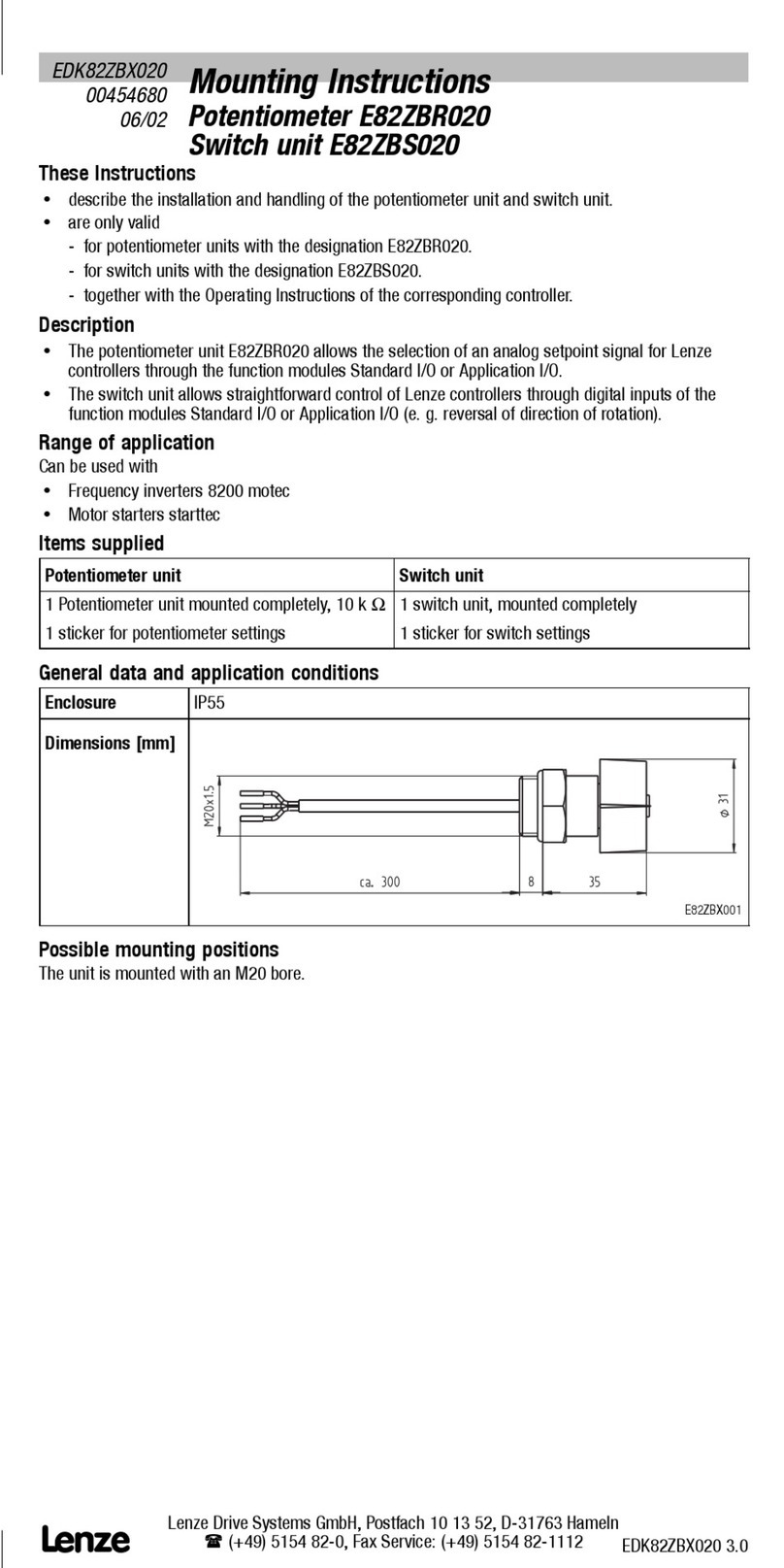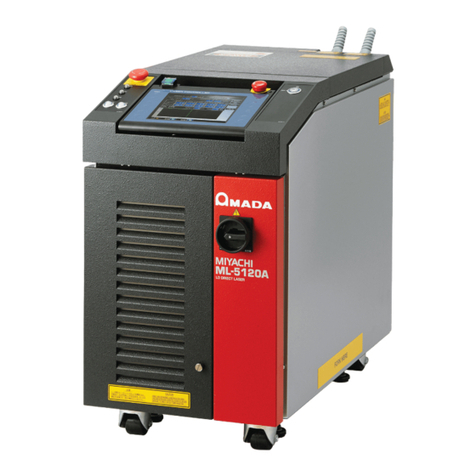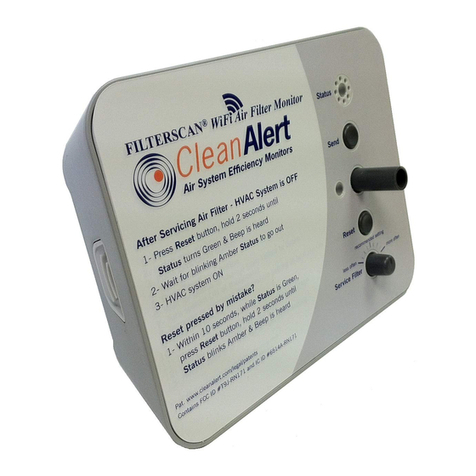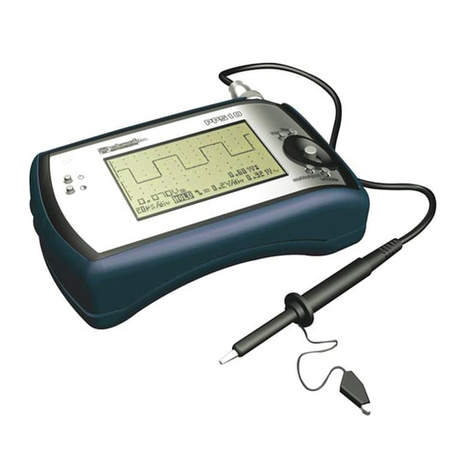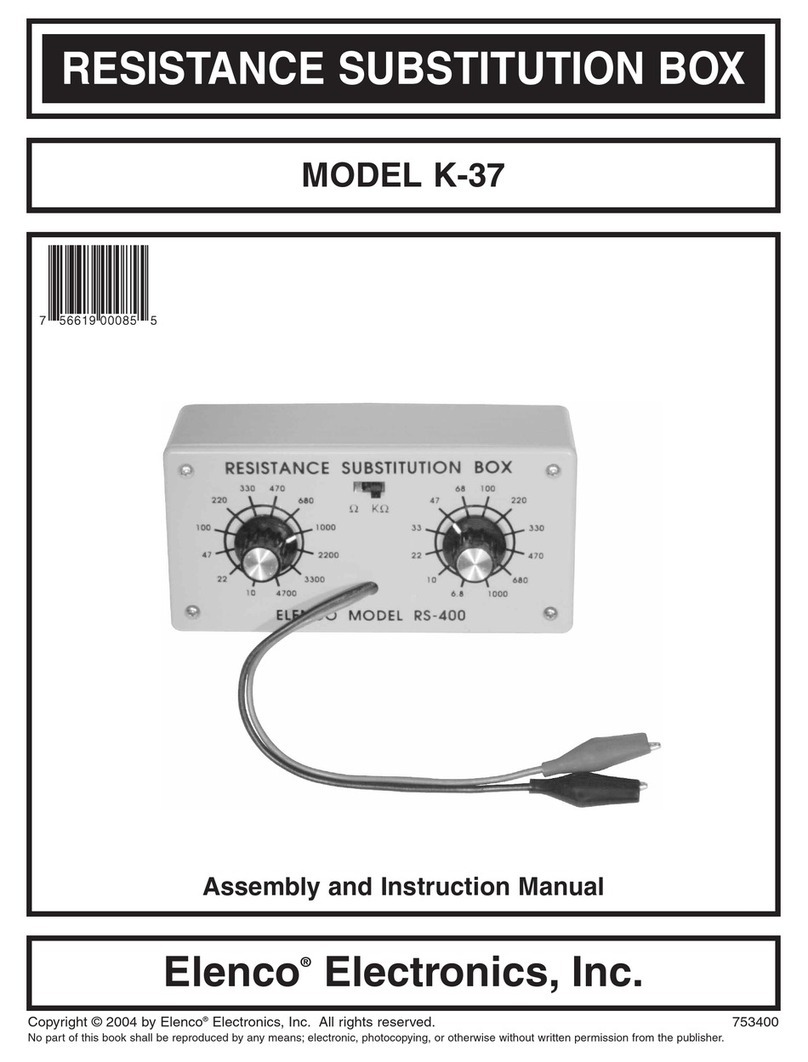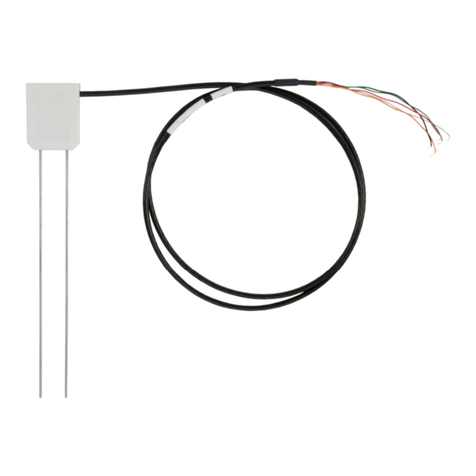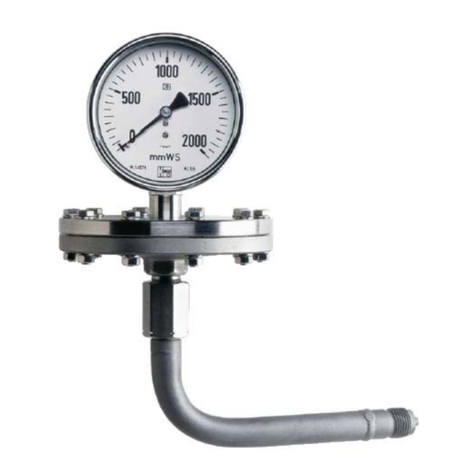Sensorex TCSMA User manual

O & M Manual 1
REV G, 7/2009
Model TCSMA
Conductivity Measurement
System
(Toroid Sensor, Blind, 2-Wire 4-20mA Transmitter)
Operation and Maintenance
Manual
11751 Markon Dr.
Garden Grove, CA 92841 USA
Tel: 714-895-4344
Fax: 714-894-4839
www.sensorex.com

O & M Manual 2
REV G, 7/2009
PRODUCT WARRANTY
SENSOREX warrants all products to be free of defects in materials and
workmanship for 1 year from date marked on the product. However, SENSOREX
offers no warranty, either expressed or implied, as to the useful life of these
products. There are no implied warranties of merchantability or fitness for a
particular purpose given in connection with the sale of any goods. In no event
shall SENSOREX be liable for consequential, incidental or special damages.
The buyer’s sole and exclusive remedy and the limit of SENSOREX’s liability for
any loss whatsoever shall not exceed the purchase price paid by the purchaser
for the product to which claim is made.

O & M Manual 3
REV G, 7/2009
Table of Contents
Part 1 Introduction
1.1 General 5
1.2 Features 5
1.3 TCSMA System Specifications 6
1.4 TCSMA Performance Specifications 8
Part 2 Transmitter Mounting
2.1 General 9
2.2 Wall Mount 9
2.3 Pipe Mount 9
2.4 Panel Mount 9
Part 3 Sensor Mounting
3.1 General 13
Part 4 Transmitter Electrical Installation
4.1 General 14
4.2 Power 14
4.3 Load Drive 15
Part 5 Sensor Electrical Connection
5.1 General 17
5.2 Direct Sensor Connection 17
5.3 Junction Box Connection 18
Part 6 Calibration
6.1 General 19
6.2 User Interface 19
6.21 Offset Adjustment 19
6.22 Coarse Span Adjustment 19
6.23 Fine Span Adjustment 19
6.24 Range Selection 19
6.25 Temp Comp Adjustment 20
6.26 REV/DIR Switch 20
6.27 Loop Current 20
6.28 Cell Drive 20
6.3 Conductivity Calibration 21
6.4 Reverse Operation 23
Table of Contents (continued)

O & M Manual 4
REV G, 7/2009
Part 7 System Maintenance
7.1 General 24
7.2 Transmitter Maintenance 24
7.3 Sensor Maintenance 24
Part 8 Service
8.1 General 25
8.2 External Sources of Problems 25
8.3 Transmitter Tests 26
8.4 Sensor Tests 26
8.5 Spare Parts List 27
Diagrams and Illustrations
Figure 1-1 Specifications - Views 7
Figure 2-1 TCSMA Mounting Details 10
Figure 2-2 Panel Mount and Cut-Out 13
Figure 4-1 Loop Power Connection 15
Figure 5-1 Bulkhead Connection 17
Figure 8-1 Pt1000 RTD Table 27

O & M Manual 5
REV D, 2/2007
Part 1 - Introduction
1.1 General The Model TCSMA is a blind, loop-powered monitoring
system, designed for the continuous measurement of
solution conductivity. The full scale operating range of the
transmitter may be user adjusted to any value between 500
uS and 1,000,000 uS using the same sensor. The sensing
system will operate on water streams with temperatures from
-5°C to 110C.
1.2 Features - Special toroidal sensor design greatly minimizes sensor
fouling and, therefore, reduces maintenance requirements.
- Standard main module is designed to be a fully isolated, loop
powered instrument for 2-wire DC applications.
- Can be user-adjusted for specific application span from 500
uS to 1,000,000 uS using the same sensor.
- Direct/Reverse operation allows 4-20 mA output direction to
be flipped.
- Adjustable temperature compensation from 0% to 4% per °C
to match solution requirements.
- Loop indicator LED glows to indicate loop current level.
- Instrument supplied in rugged NEMA 4X enclosure with
multi-purpose mounting bracket.

TCSMA Conductivity System Part 1 - Introduction
O & M Manual 6
REV G, 7/2009
1.3 TCSMA System Specifications
Measuring Range Manual selection of one of the following ranges,
500 to 2,500 uS/cm
2,500 to 15,000 uS/cm
15,000 to 100,000 uS/cm
100,000 to 1,000,000 uS/cm
Enclosure NEMA 4X, IP66, polycarbonate, stainless steel
hardware, weatherproof and corrosion resistant,
HWD: 4.4" (112 mm) x 4.4" (112 mm) x 3.5" (89
mm)
Mounting Options Wall, panel, pipe, DIN rail, or integral-sensor.
Conduit Openings Standard: 1 - PG-9 opening, 1 - 1" NPT center
opening, cordgrips and PG-11 adapter included.
Weight 1 lb. (0.45 kg)
Ambient Temperature Transmitter Service, -20 to 60 °C (-4 to 140 ºF)
Sensor Service, -5 to 110°C (23 to 230 °F)**
Storage, -30 to 70 °C (-22 to 158 ºF)
Ambient Humidity 0 to 95%, non-condensing
Location Designed for hazardous and non-hazardous areas
EMI/RFI Influence Designed to EN 61326-1
Output Isolation Inherently isolated by sensor design
Temperature Input Pt1000 RTD with automatic compensation,
compensation adjustable from 0.0 to 4.0%/°C.
Sensor Noryl body toroidal, 150 psig max, ¾” NPT rear
process connection, P1000 RTD, CPVC 20 ft
length integral cable.
Max. Sensor-to-Transmitter
Distance 200 feet (61 meters)
Power 16-35 VDC (2-wire device)
DC Cable Type Belden twisted-pair, shielded,
Maximum length 3000 ft (914 meters)
Insertion Loss 16 VDC
** Note – sensor cable limited to 105°C max temperature when dry and 70°C max temperature if
submerged.

TCSMA Conductivity System Part 1 - Introduction
O & M Manual 7
REV G, 7/2009
Figure 1-1 Specifications - Views
Inches
(
mm
)
1” NPT
WITH PG-11
ADAPTER
AND PG-11
CORD GRIP

TCSMA Conductivity System Part 1 - Introduction
O & M Manual 8
REV G, 7/2009
1.4 TCSMA Performance Specifications
Repeatability 0.2% of selected range
Sensitivity 0.1% of selected range
Non-linearity 0.5% of selected range
Stability 0.2% of range per 24 hours, non-cumulative
Temperature Drift 0.06% of range/°C, span or zero
Response Time 2 seconds to 90% of full-scale step input

O & M Manual 9
REV D, 2/2007
Part 2 – Transmitter Mounting
2.1 General A bracket is included with each unit that allows mounting to
walls, pipes and DIN rail. In all cases, choose a location that
is readily accessible for calibrations. Also consider that it
may be necessary to utilize a location where solutions can
be used during the calibration process.
Locate the instrument in close proximity to the point of
sensor installation - this will allow easy access during
calibration. The sensor-to-instrument distance should not
exceed 200 feet. To maximize signal-to-noise ratio however,
work with the shortest sensor cable possible. The standard
cable length of the sensor is 20 feet (6.1 meters).
2.2 Wall Mount The instrument may be easily wall mounted (see Figure 2-1
details). The multi-purpose bracket is attached to the rear of
the enclosure using the four provided pan head screws. The
protrusion side of the multi-purpose bracket should face into
the depression on the rear of the instrument enclosure. The
instrument is then attached to the wall using the four outer
mounting holes in the bracket.
2.3 Pipe Mount For the pipe-mounting configuration, the multipurpose
bracket is attached to the rear of the enclosure with the four
provided screws. The protrusion on the bracket must face
outward. The bracket may be rotated for proper alignment
prior to mounting (see Figure 2-1 for details).
Once the bracket is fastened to the rear of the enclosure, the
provided pipe clamp must be completely opened and slipped
through the two slots in the multi-purpose mounting bracket.
The clamp is then looped around the pipe, re-attached, and
tightened.

TCSMA Conductivity System Part 2 – Transmitter Mounting
O & M Manual 10
REV G, 7/2009
Figure 2-1 Mounting Bracket Details
Inches
(
mm
)

TCSMA Conductivity System Part 2 – Transmitter Mounting
O & M Manual 11
REV G, 7/2009
2.4 Panel Mount In the panel mount configuration, the entire enclosure is
panel-mounted using a special optional sealing flange – as
shown in Figure 2-2. The panel mount kit, part number
07-0204, must be ordered separately.
The sealing flange must first be attached to the enclosure.
Fasten the flange to the rear half of the enclosure using the
four hex retainers. The flange gasket material must face
towards the rear of the enclosure. The flange is now
installed. Seal up the finished enclosure by tightening down
the four enclosure screws prior to mounting.
A special cut-out is required for this configuration, as shown
in Figure 2-2. Once the cut-out has been completed, insert
the flanged enclosure through the cut-out. The mounting
bracket is then attached to the rear of the enclosure as
shown. Install the four tension screws through the four
mounting holes in the bracket, and place the no-slip rubber
boots on each screw. Tighten all screws down to seal the
enclosure flange onto the panel.

TCSMA Conductivity System Part 2 – Transmitter Mounting
O & M Manual 12
REV G, 7/2009
Figure 2-3 Panel Mount and Cut-out
Inches
(
mm
)

O & M Manual 13
REV D, 2/2007
Part 3 – Sensor Mounting
3.1 General Select a location within the maximum sensor cable length for
mounting of the sensor flow cell. Locate sensor away from
pumps, adjustable frequency drive systems, or other sources
of high frequency EMI if possible. Once submerged, verify
that the sensor has the proper minimum 2” clearance to tank
walls or other objects nearby the sensor mounting. Close
proximity to objects can cause the sensor to read falsely
high or low. If in-line mounted, as in a tee application, the
sensor will stay cleaner if it is faced up or down stream so
that the line flow goes directly through the sensor bore.
Contact the factory for information on submersion hardware
mounts and tee mounts.

O & M Manual 14
REV D, 2/2007
Part 4 – Transmitter Electrical Installation
4.1 General The TCSMA loop-powered instrument is a 16-35 VDC
powered transmitter.
WARNING: Do not connect AC line power to the 2-wire
module. Severe damage will result.
Important Notes:
1. Use wiring practices that conform to all national, state
and local electrical codes.
2. Do NOT run sensor cables or instrument 4-20 mA output
wiring in the same conduit that contains AC power wiring.
AC power wiring should be run in a dedicated conduit to
prevent electrical noise from coupling with the
instrumentation signals.
4.2 Power A separate DC power supply must be used to power the
instrument. The exact connection of this power supply is
dependent on the control system into which the instrument
will connect. See Figure 4-1 for further details. Any general
twisted pair shielded cable can be used for connection of the
instrument to the power supply. Route signal cable away
from AC power lines, adjustable frequency drives, motors, or
other noisy electrical signal lines. Do not run sensor or
signal cables in conduit that contains AC power lines or
motor leads.
.

TCSMA Conductivity System Part 4 – Transmitter Electrical Installation
O & M Manual 15
REV G, 7/2009
Figure 4-1 Loop-Power Connection
4.3 Load Drive The two-wire instrument can operate on a power supply
voltage of between 16 and 35 VDC. The available load drive
capability can be calculated by applying the formula V/I=R,
where V=load drive voltage, I=maximum loop current (in
Amperes), and R=maximum resistance load (in Ohms).
To find the load drive voltage of the two-wire TCSMA,
subtract 16 VDC from the actual power supply voltage being
used (the 16 VDC represents insertion loss). For example, if
a 24 VDC power supply is being used, the load drive voltage
is 8 VDC.
The maximum loop current of the two-wire TCSMA is always
20.00 mA, or .02 A. Therefore,
TRANSMITTER
POWER SUPPLY
24 VDC
LOAD
(+)
(-)
(+)
(-)
(+) (-)
(Power Supply Voltage - 16)
.02 = RMAX

TCSMA Conductivity System Part 4 – Transmitter Electrical Installation
O & M Manual 16
REV G, 7/2009
For example, if the power supply voltage is 24 VDC, first
subtract 16 VDC, then divide the remainder by .02. 8/.02 =
400; therefore, a 400 Ohm maximum load can be inserted
into the loop with a 24 VDC power supply.
Similarly, the following values can be calculated:
Power Supply Voltage (VDC) Total Load (Ohms)
16.0 0
20.0 200
24.0 400
30.0 700
35.0 950

O & M Manual 17
REV D, 2/2007
Part 5 – Sensor Electrical Connection
5.1 General The sensor cable can be quickly connected to the TCSMA
terminal strip by matching the wire colors on the cable
conductors. A junction box is suggested to provide a quick-
disconnect point for the sensor, or a break point for very long
sensor cable runs. Route signal cable away from AC power
lines, adjustable frequency drives, motors, or other noisy
electrical signal lines. Do not run sensor or signal cables in
conduit that contains AC power lines or motor leads.
5.2 Direct
Sensor
Connection Route the sensor cable into the enclosure through the center
PG-11 cord grip only. If the cord-grip devices are used for
sealing the cable, make sure the cord-grips are snugly
tightened after electrical connections have been made to
prevent moisture incursion. When stripping cables, leave
adequate length for connections in the transmitter enclosure,
as shown below.
Figure 5-1 Bulkhead Connection

TCSMA Conductivity System Part 5 – Sensor Electrical Connection
O & M Manual 18
REV G, 7/2009
Once inside the enclosure, the individual colored sensor
sensor cable leads can be connected directly to the
SENSOR connection terminals by matching the wire colors.
5.3 J-Box
Connection For installations where the sensor is to be located more than
20 feet from the transmitter, a customer supplied junction
box should be used.

O & M Manual 19
REV D, 2/2007
Part 6 – Calibration
6.1 General The transmitter is factory calibrated in a default range of 0-
10,000 uS/cm. The transmitter must be re-calibrated with
the actual sensor for optimum accuracy using the following
procedure.
6.2 User
Interface The user interface controls for the transmitter are quite
simple, and they are described below.
6.21 Offset
AdjustmentThe offset adjustment sets the 4 mA output current
point for the system. This adjustment is made after
the proper range has been selected, and the sensor is
held in air. Offset adjustments can only be made to
zero-signal conductivity.
6.22 Coarse Span
AdjustmentThe coarse span adjustment sets the initial 20 mA
output current point for the system. This adjustment
is used to make the initial rough adjustment on the
sensor span.
6.23 Fine Span
AdjustmentThe fine span adjustment sets the final 20 mA output
current point for the system. This adjustment is used
to make the final, precise, adjustment on the sensor
span.
6.24 Range
Selection This dipswitch selects the general range of operation
for the transmitter. Pick the range to be larger than
the maximum operating conductivity value of the
transmitter.
RANGE CELL DRV
500 uS – 2,500 uS 1-ON, 2-ON 1-ON, 2-OFF
2,500 uS – 15,000 uS 1-ON, 2-OFF 1-ON, 2-OFF
15,000 uS – 100,000 uS 1-OFF, 2-OFF 1-ON, 2-OFF
100,000 uS – 1,000,000 uS 1-OFF, 2-OFF 1-OFF, 2-ON

TCSMA Conductivity System Part 6 - Calibration
O & M Manual 20
REV G, 7/2009
Due to the nature of the sensor design, it is
recommended to use the largest range possible for
the application. The higher instrument ranges are
easier to user calibrate, as they require less back-
and-forth zero/span adjustments.
6.25 Temperature
Compensation
AdjustmentThe TC % PER C adjustment sets the specific linear
temperature compensation factor for the measured
solution. The range of adjustment is from 0-4%/C.
Since the majority of aqueous solutions are
compensated at approximately 2%/C, leave this
setting at the default 2%/C setting if the exact
compensation requirement is not known. The
following list contains some common factor settings:
1.9 Sodium Hydroxide
1.5 Hydrochloric Acid
1.5 Sulfuric Acid
1.5 Nitric Acid
1.1 Phosphoric Acid
2.1 Sodium Chloride
2.4 Sodium Sulfate
2.2 Sodium Nitrate
2.0 Potassium Chloride
6.26 REV/DIR
Switch This switch sets the direction of output change for the
system. In the direct mode (DIR), the output current
will increase to 20 mA as the conductivity increases.
In the reverse mode (REV), the output current will
decrease to 4 mA as conductivity increases.
6.27 Loop
Current This indicator glows when the transmitter is powered
and operating correctly. The intensity of the light will
increase with increasing output current.
6.28 Cell
Drive This switch sets the sensor drive potential and is used
to set the instrument range of operation (see section
6.24.)
Table of contents
Other Sensorex Measuring Instrument manuals


